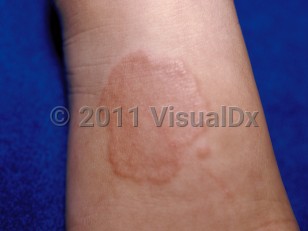Granuloma annulare in Child
See also in: External and Internal EyeAlerts and Notices
Important News & Links
Synopsis

Several variants of GA exist, including localized (the most common), generalized, subcutaneous, perforating, macular, vesicular, palmoplantar, and blaschkolinear variants. Generalized forms of GA are more chronic or persistent than localized forms. Palmoplantar GA can be painful. The subcutaneous variant occurs almost exclusively in children and favors the lower extremities.
Human leukocyte antigen (HLA)-Bw35 has been associated with generalized GA and thyroid disease.
GA may have a prolonged course, but lesions tend to spontaneously resolve without scarring.
Codes
L92.0 – Granuloma annulare
SNOMEDCT:
65508009 – Granuloma annulare
Look For
Subscription Required
Diagnostic Pearls
Subscription Required
Differential Diagnosis & Pitfalls

Subscription Required
Best Tests
Subscription Required
Management Pearls
Subscription Required
Therapy
Subscription Required
Drug Reaction Data
Subscription Required
References
Subscription Required
Last Updated:10/12/2020
 Patient Information for Granuloma annulare in Child
Patient Information for Granuloma annulare in Child- Improve treatment compliance
- Reduce after-hours questions
- Increase patient engagement and satisfaction
- Written in clear, easy-to-understand language. No confusing jargon.
- Available in English and Spanish
- Print out or email directly to your patient



